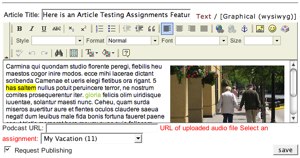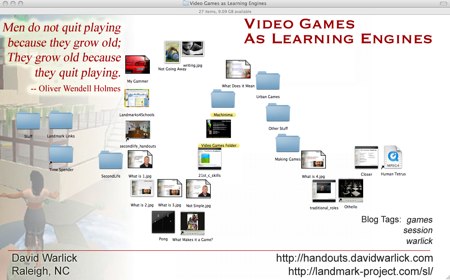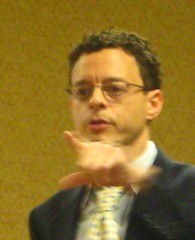 I love that American Airlines now has electric outlets at most of the seats of their larger planes, MD-80s (Mad Dog 80) and up. It makes such a difference, especially considering the multitude of hours I’ll be in the air between Dallas and Honolulu — have to admit that’s sounding pretty exciting now.
I love that American Airlines now has electric outlets at most of the seats of their larger planes, MD-80s (Mad Dog 80) and up. It makes such a difference, especially considering the multitude of hours I’ll be in the air between Dallas and Honolulu — have to admit that’s sounding pretty exciting now.
As I was finishing up a blog entry at gate C15, across from me sits Bethany Smith. I’m not sure what her job is, but Bethany works at the Friday Institute, which I’ve blogged about on several occassions. She’s become a go-to person for several specific technology applications including podcasting and Moodle. She’s on her way to San Francisco for a Moodle conference. Bethany is also involved in an initiative at North Carolina State University to re-invent their educator pre-service program, which I hope to be a part of — schedule permitting.
We talked a bit about Moodle and how NCSU is looking to adopt the software for their online learning programs. She’s obviously an enthusiast, but equally versed in BlackBoard, Web CT, and their combined product(s). At any rate is was nice to have someone so pleasant to talk to at the airport.
For most of the rest of these flights, I’ll be finishing up an article about Personal Learning Networks (PLN) and simultaneously finishing up a re-build of my PLN conference presentation, which I’ll be doing three or four times at EdTech, in Honolulu. One thing that I want to do is to reconcile the fact that there is nothing new about personal learning networks (just like there’s nothing new about do it yourself (DIY) education practices — aka, Edupunk).
I’m struggling with the fear that I may be de-constructing PLN techniques a little too much, for the sake of acknowledging what many will say, “Hey! We’ve been doing that for years!” It’s true. But in the case of PLNs, new information and communication technologies have availed dramatically new avenues for learning from each other and for learning by mining larger conversations for value. Also critical to this conversation is how important lifelong learning (learning lifestyle) is to education and how necessary it is for teachers to not only practice it, but model the skills of using the networks for learning.
More about DIY/Edupunk later — perhaps the next flight.



 Too late, I caught up with an e-mail from Norm Sutaria about a resource that would have come in quite handy for my video games presentations this week, in Bismarck. It’s a recent blog post in Jeff Cobb’s
Too late, I caught up with an e-mail from Norm Sutaria about a resource that would have come in quite handy for my video games presentations this week, in Bismarck. It’s a recent blog post in Jeff Cobb’s 
 a teacher came up to me and asked some important questions about
a teacher came up to me and asked some important questions about  But what really works for me is that
But what really works for me is that 
 I was especially taken with his suggestion that if you have been asked to appeal to your school board, county commissioners, legislative education committee — or whatever, then don’t bring a class of kids to show what they’re doing with technology. He said that we should learn about the members of the committee, learn if they have school aged children or grand children, find out what school they attend, and learn what’s going on with technology in their school. Then suggest, are your children, Mrs. Green, learning these 21st century skills in her classrooms, where they only have one computer and have to share a projector with 12 other classrooms, where they science textbook is six years old, and many of the most up-to-date science and health information resources on the Internet are blocked? He confessed that this borderlines stalking, but I think that the point was well made. To appeal to people, you have to make it personal.
I was especially taken with his suggestion that if you have been asked to appeal to your school board, county commissioners, legislative education committee — or whatever, then don’t bring a class of kids to show what they’re doing with technology. He said that we should learn about the members of the committee, learn if they have school aged children or grand children, find out what school they attend, and learn what’s going on with technology in their school. Then suggest, are your children, Mrs. Green, learning these 21st century skills in her classrooms, where they only have one computer and have to share a projector with 12 other classrooms, where they science textbook is six years old, and many of the most up-to-date science and health information resources on the Internet are blocked? He confessed that this borderlines stalking, but I think that the point was well made. To appeal to people, you have to make it personal.![Warning Message from Wikipedia [click to enlarge] Picture of Warning Message from Wikipedia](http://davidwarlick.com/images/neologism_sml-20080602-070032.jpg)